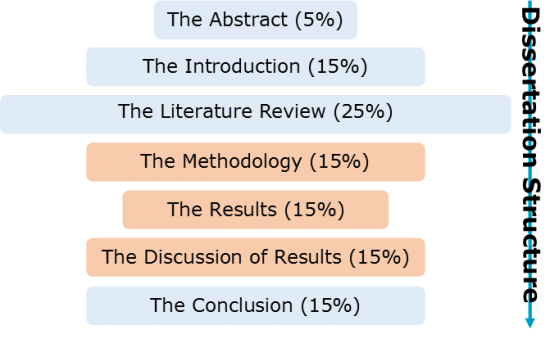What are the seven sections of a dissertation?

This is the second of three chapters about Dissertations. To complete this reader, read each chapter carefully and then unlock and complete our materials to check your understanding.
– Discuss the overall dissertation structure
– Explore the common elements of a dissertation
– Consider additional elements which may be added
Chapter 1: What is an academic dissertation?
Chapter 2: What are the seven sections of a dissertation?
Chapter 3: What is an effective dissertation topic?
Chapter 2
When writing a dissertation, like any type of essay, it’s important that relatively inexperienced writers follow tried and trusted structures and methods so as to convey ideas, arguments and research as clearly and easily as possible. This chapter therefore offers one such prescribed structure that’s particularly used in social-science dissertations, such as for linguistics, psychology or anthropology. Although other subjects may of course use a slightly different number of sections, place these seven sections in a slightly different order, or expect a different weighting for each section, the example structure we’ve included below should cover most dissertation and thesis types that students will be required to produce.

1. The Abstract (5%)
Both the shortest and first-encountered section of a dissertation, the abstract is intended to provide a very brief overview of the entire research project, highlighting to the reader the aims of the dissertation, the background and context of the investigation, the methodology that’s been used, the study’s key findings, and how this particular study has contributed to the field of knowledge.
2. The Introduction (15%)
Following the abstract, the purpose of the introduction is usually to describe the focus of the dissertation by reviewing the topic’s background and context. An introduction may also identify gaps in the research and how the writer intends to fill those gaps, as well as an outline of the scope of the investigation and the general and argumentative structure of the dissertation.
3. The Literature Review (25%)
The largest section of a dissertation is usually the literature review, which aims to provide a detailed discussion of the existing research that’s most relevant to the investigation. This section usually includes a critical review of both non-research and research literature, as well as any theoretical perspectives that require understanding to support and contextualise the study. Additionally, identification and justification of the research gap being filled in this dissertation as well as an explanation of how all of the above features have informed the dissertation are generally included.
4. The Methodology (15%)
The methodology is usually where the primary (and original) research of the dissertation begins. The purpose of this section is to highlight and justify to the reader the approach, design and processes that were followed to collect the findings, such as whether qualitative or quantitative methods were employed and whether questionnaires, interviews or recordings were used to collect the raw data. This section may include the study’s methodological approach, the research design, justification of the methods used, a discussion of the reliability and validity of those methods, and a description of the data collection and analysis procedures.
5. The Results (10%)
The fifth section (which is sometimes combined with the sixth section) of a dissertation is usually focussed on the results. The primary aim of this chapter is to present the results of the study’s primary research in a clear manner that demonstrates how these results address the dissertation’s research questions. Generally, in the results section the writer will present the relevant findings of the study, explain the implications of those findings, present evidence to support those findings, refer back to the methodology and introductory background information, and perhaps also refer forwards to the discussion of results.
6. The Discussion of Results (15%)
While the results section deals with the raw data, the discussion of results is where these findings are contextualised and their significance explained. As well as reminding the reader of the research aims and how the study’s results work to explore these aims, the writer should additionally present a discussion of how these findings have contributed to the dissertation’s hypotheses and therefore to the overall literature. Some time may also be spent interpreting the study’s findings, comparing them to other research, and evaluating their contribution to the literature.
7. The Conclusion (15%)
The final section of a dissertation is called the conclusion, the purpose of which is to remind the reader of the study’s aims, the key methodology, and the findings of the investigation. The writer may also wish to evaluate the significance of the research, commenting on how this research further develops the theory as well as highlighting any limitations that may have become apparent during the investigation. Finally, how this research can be applied practically may also be outlined to the reader, and any research gaps generated by the study explained.
Additional Sections
While these seven sections constitute the bulk of the dissertation, don’t forget to also include a table of contents, a reference list and an appendix if necessary.
Now that we’ve discussed what a dissertation is, when one might be used, and which sections such an extended essay usually contains, the final chapter on this subject is about choosing an effective dissertation topic.
To reference this reader:
Academic Marker (2022) About Dissertations. Available at: https://academicmarker.com/essay-writing/dissertations/about-dissertations/ (Accessed: Date Month Year).
Downloadables
Once you’ve completed all three chapters about dissertations, you might also wish to download our beginner, intermediate and advanced worksheets to test your progress or print for your students. These professional PDF worksheets can be easily accessed for only a few Academic Marks.
Collect Academic Marks
-
100 Marks for joining
-
25 Marks for daily e-learning
-
100-200 for feedback/testimonials
-
100-500 for referring your colleages/friends